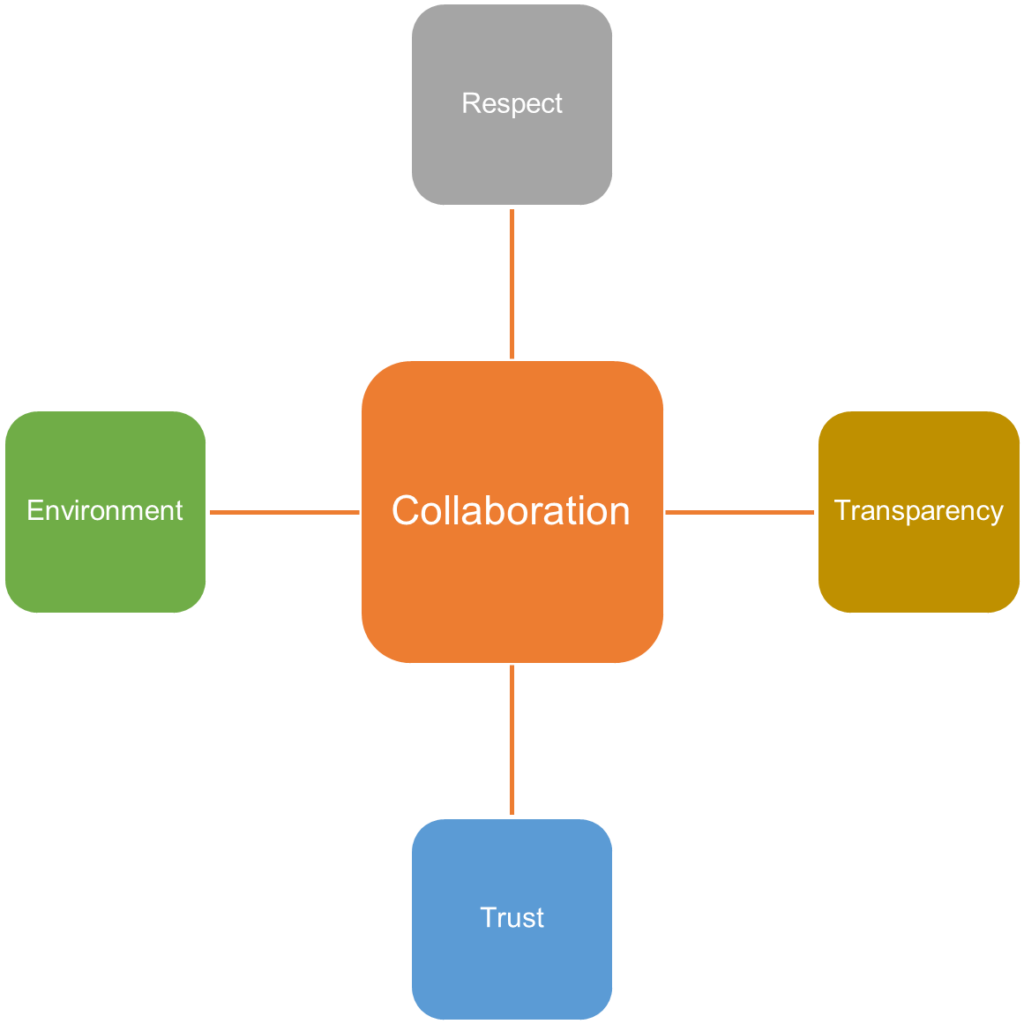The need for enterprise collaboration as well as an online collaboration tool has never been so much as in the past twelve months. However, it is somewhat strange that most business managers and professionals mistake collaboration for the use of software tools, the growth of which has been extraordinary – thanks to COVID-induced work-from-home. Statistics reveal an exponential rise in the adoption of collaboration tools such as Zoom, Microsoft Teams, WebEx, Google Meet, etc.
Now, let us look at companies.
There are bad companies. There are good companies. And there are great companies.
What makes some companies great, and others just ordinary?
Is it the quality of their products and services? Is it the organizational processes and tools? Is it the competency of their people?
Maybe, maybe not!
While discussions and conversations about organizational success may turn toward processes, tools, skills, one aspect that gets very little focus is – collaboration! Research indicates that a major factor behind the organizational success – both in ‘normal’ times and in ‘crises’ is collaboration.
An HBR research (Exhibit 1) of a global law firm highlights the impact of collaboration during and after the 2007-2008 financial crisis in the US.
Exhibit 1
_____________________________________________________________________________________________________________________________________________________

Source: www.hbr.org
On a slightly different note, the below graphic (Exhibit 2) is from a McKinsey study that outlines the value of collaboration in different business activities.
Exhibit 2
_____________________________________________________________________________________________________________________________________________________

Source: www.mckinsey.com
When professionals talk about enterprise collaboration, they focus mostly on collaboration ‘enabling’ tools. With these tools, organizations expect enhanced collaboration – nothing can be farther from the truth!
Most professionals mistake collaboration as the ability to effectively communicate with one another. Organizations presume implementing an enterprise collaboration tool would lead to enhanced team collaboration.
Collaboration is much more than mere communication – face-to-face or virtual.
The pillars of collaboration.
Let us get to the basics of collaboration.
As humans, we tend to be comfortable working with a fellow-human when we know that we are first ‘respected’ for what we are and then for our views and opinions.
So, the first pillar of collaboration foundation is mutual respect.
Let us move to the next dimension.
People prefer working along with those that do not hide information deliberately or those who do not try to manipulate others for their selfish benefits.
The second pillar of collaboration is transparency.
Now for the third dimension.
While working with one another, people continuously observe for consistency in speech as well as action. Does she say what she does, and does she do what she says? Or does the person ‘walk the talk’? Whenever there is a disconnect, the ‘trust’ gets broken!
The third pillar of collaboration is trust.
Let us now consider the last dimension.
Top management must ensure that the organizational culture fosters an environment of respect, transparency, and trust. Leaders must institutionalize norms of acceptable behavior or code of conduct along with redressal mechanisms. Additionally, the senior executives must first ‘walk the path’ before they expect their teams to follow suit.
The fourth and the last pillar happens to be a conducive organizational environment for collaboration to thrive.
Exhibit 3
_____________________________________________________________________________________________________________________________________________________

Drivers of Collaboration
Now that we have understood the dimensions of collaboration, let us turn our gaze towards the need for online collaboration tools in the present world.
The COVID-19 pandemic has significantly altered the way the world works. Industry veterans and business leaders are not willing to bet if the world would get back to a life that existed ‘pre-COVID’ – even if it did, organizations are not willing to be ‘bitten twice.’ When we gloss over the recent global events and industry actions, it appears that businesses would move all the work that could be accomplished – ‘virtually.’
What are the implications of ‘working virtually’?
The obvious ones include:
- Reduced cost of business operations through office space, real-estate, administration, housekeeping, and others.
- Ability to seek talent wherever it resides – on this planet!
- Employees could spend more time with family, and…
- the list goes on.
Amongst all these gains, the biggest casualty would be – employee collaboration!
It is also true that organizations have rapidly embraced tools such as Zoom, Microsoft Teams, Google Meet, WebEx, and others.
Let us ask one question – do these tools enable collaboration? At the most, they enable a few aspects of our interactions such as:
- exchanging messages and documents
- scheduling and managing team meetings
- recording conversations
- sharing common documents
One of the drawbacks of most of the tools mentioned above is: they do not capture ‘tacit’ interactions especially in knowledge-based work. Companies continue to struggle here. Interactions with leaders indicate that the use of the tools (indicated above) end up consuming both money and time!
Business leaders must reorient their thinking to ‘network analysis’ of professionals to analyze employees that take part in interactions that drive time savings – both greatest and lowest. When aggregated at the enterprise level, network analysis could offer insights about economic value creation as well as collaborative breakdowns!
When executed right, research indicates that digital collaboration could unlock more than $100 billion in value, driven by boosted productivity (of 20% – 30%).
How should enterprises approach digital collaboration?
For organizations to leverage digital collaboration via enterprise collaboration tools, they must consider embedding digital collaboration into business processes-related workflows. What does this entail? Let us explore.
As indicated earlier, collaboration is built on respect, transparency, trust, and the environment.
Embedding digital collaboration into process workflows can enable faster, better decisions that improve key performance indicators (KPIs) and drive bottom-line value.
Let us start with respect.
The enterprise collaboration tool must couple process workflows along with timelines for responses. Consider an online project management software where a designer must approve a design within ‘x’ business hours or business days so that another project team member could go ahead with the next project deliverable. Defining ‘rules-based’ workflows ensures that employees respect the time of their colleagues.
Let us now move to transparency.
The enterprise collaboration tool must ensure that it offers transparency based on the organizational hierarchy and access control designed. For example, a project team member must be able to view all documents and specifications associated with his project deliverable – nothing more. However, a project lead should be able to view all the work of his team members.
What about trust?
Trust is very personal and is built over time. Driving with a sense of respect and transparency often leads to trust.
What about the environment?
For organizations to benefit from team collaboration tools, it is the senior management must become the harbinger of change and adoption. Only when the top management respects digital collaboration would the rest of the organization match up. For this, senior executives need to become heavy users of the chosen collaboration tool complementing with informal and ad hoc conversations. This would send a clear message to all the employees about the value of enterprise collaboration tools.
Exhibit 4 from www.mckinsey.com lucidly conveys digital collaboration and the allied benefits.
Exhibit 4
_____________________________________________________________________________________________________________________________________________________

Implementing an enterprise collaboration tool is not an option anymore – it is a hygiene factor. However, does it suggest that digital tools would completely replace human interactions?
No!
The aim of choosing the path of enterprise collaboration system must be to:
- Closely review and assess all the ‘work’ that the organization and its employees perform.
- Analyze and classify work as:
- ‘explicit’ – that which could be codified, and
- ‘tacit’ – that which is difficult to be codified.
- Enable ‘explicit’ work for digital collaboration.
- Complement ‘tacit’ work through face-to-face or virtual collaboration.
Here is a shocker!
The biggest mistake made by decision-makers while selecting online collaboration tools is that they consider collaboration and work as two distinct dimensions. They miss the fact that collaboration is not for the sake of it. Collaboration must deliver a product or service. The key takeaway is: when a company, for example, chooses a project management software, it must review project functionalities as well as inbuilt collaboration features as elaborated earlier.
But we are still human!
Business leaders must keep in mind that the essence of a digital online collaboration tool is not to eliminate the human element, but to enhance it for better business impact – by eliminating time spent on work that could be easily pushed to the digital platform. In the process, organizations foster high-value work by their employees, which in turn helps to improve employee satisfaction and gain associated benefits.
Closing thoughts.
We at ProductDossier were fortunate to discover the power of the trinity – project management, digital, and collaboration. TouchBase is built on the foundation of digital collaboration for enterprises that manage diverse projects, be it, external customers, product development, or internal initiatives.
Try TouchBase. Be delighted.





